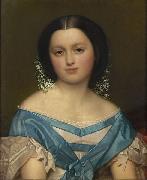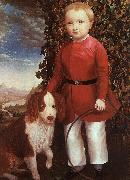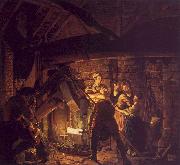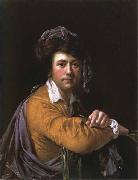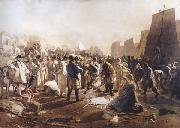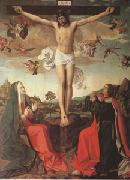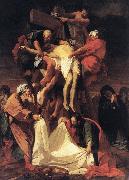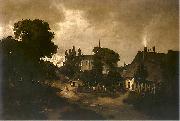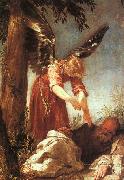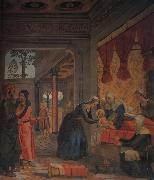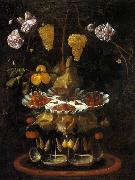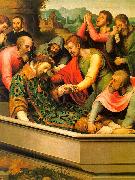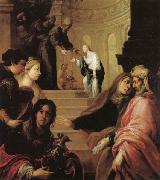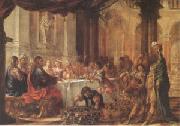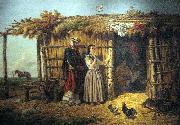|
|
|
|
|
|
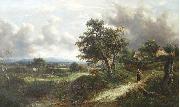 |
Joseph Thors
|
|
(ca. 1835 - 1884) was an English landscape artist who exhibited widely in England during the late 19th century.
Relatively little is known about Thors's life though he was recorded as living and working in London, then Birmingham - he also travelled for a while in France. He exhibited at the Royal Academy of Arts, British Institution, and Society of British Artists in London, and was also exhibited in Birmingham between 1869 - 1900. |
|
|
|
|
|
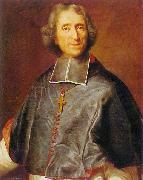 |
Joseph Vivien
|
|
(1657 - 5 December 1735) was a French painter of Lyon.
He left his native Lyon for Paris at the age of twenty and found employment in the large atelier of Charles Le Brun, the equivalent of an academy. He made his reputation by his portraits in pastels, to which he gave a sparkle and immediacy hitherto unreached in that medium.
He was received in the Academie royale de peinture et de sculpture in 1701, under the designation peintre en pastel. He was appointed counsellor to the Academy and provided lodging under royal auspices at the royal manufactory of the Gobelins.
From Paris he visited Brussels. Vivien was taken up by the francophil Elector of Cologne and worked at Munich, as first painter to the Elector's brother, Maximilian Emmanuel, Elector of Bavaria. |
|
|
|
 |
Joseph Wolf
|
|
(January 22, 1820 - April 20, 1899) was a German artist who specialized in natural history illustration. He moved to the British Museum in 1848 and became the choice of illustrator for numerous explorers and collectors. He depicted animals accurately in life-like postures and has been considered one of the great pioneers of wildlife art. Sir Edwin Landseer considered him ...without exception, the best all-round animal artist who ever lived.
Wolf was the son of a farmer, and was born in Mörz near Menstermaifeld, not far from the river Moselle, in the Eifel region. In his boyhood he was an assiduous student of bird and animal life, and showed a remarkable capacity as a draughtsman of natural history subjects.
At the age of sixteen he went to Koblenz to work for a firm of lithographers, and then in 1840 he moved to Frankfurt. Here he provided the illustrations for Eduard Reppell's Birds of Northeast Africa. |
|
|
|
|
|
 |
Joseph-Benoit Suvee
|
|
(3 January 1743 - 9 February 1807) was a Flemish painter strongly influenced by French neo-classicism.
He was born in Bruges. Initially a pupil of Matthias de Visch, he came to France aged 19 and became a pupil of Jean-Jacques Bachelier. In 1771, he won the Prix de Rome. In Rome from 1772 to 1778, he prolonged the usual duration allowed to pensionaries of the French Academy in Rome. He was named an academician on his return to Paris and he opened an art school for young women at the Louvre. He emulated and competed with Jacques-Louis David, earning his enduring hatred.
Named the French Academy in Rome's director in 1792, replacing François-Guillaume Menageot, he was imprisoned for a while in the Prison Saint-Lazare and only able to take up the post in 1801. After a brilliant career, and a six years' stay in Rome as the Academy's Director, he died there suddenly.
His works include Achilles depositing the body of Hector at the feet of the body of Patroclus, (1769, Louvre), and Cornelia, mother of the Gracchi, (1795, Louvre).
|
|
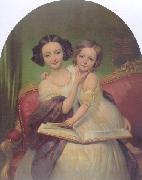 |
Joseph-Desire Court
|
|
a painter of historical subjects and portraits, was born at Rouen in 1797. He became a pupil at the École des Beaux-Arts under Gros, and after carrying off the principal honours there pursued his studies still further at Rome. High expectations were formed of him when he exhibited in 1827 'The Death of Caesar,' a work manifesting earnest thought, and a conscientious handling of the facts of history. This is now preserved in the Louvre. Having shown himself in this and other works a vigorous painter, capable of seizing a subject with a masterly grasp, and having also in the region of portrait painting proved himself an artist of no common merit, he eventually dissipated his talents in the production of a series of empty official pictures painted by order of Louis Philippe. He died in Paris in 1865. The Bordeaux Museum has a portrait of Henri Fonfrede by him; that of Lyons, a 'Scene in the Deluge'; that of Rouen, |
|
|
|
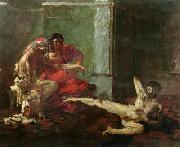 |
Joseph-Noel Sylvestre
|
|
(1847-1926) was a French artist, notable for his studies of classic scenes from antiquity. He was born in Beziers in South-West France on 24 June 1847, training as an artist first in Toulouse under Thomas Couture, then at the École des Beaux-Arts in Paris under Alexandre Cabanel. He was an exponent of the romantic Academic art style, also known as art pompier (fireman's art), examples of which are the Death of Seneca (1875), The Gaul Ducar decapitates the Roman general Flaminus at the Battle of Trasimene (1882), The Sack of Rome by the barbarians in 410 (1890) and François Rude working on the Arc de Triomphe (1893). |
|
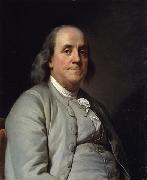 |
Joseph-Siffred Duplessis
|
|
(22 September 1725 - 1 April 1802) was a French painter, known for the clarity and immediacy of his portraits.
He was born in Carpentras, near Avignon, into a family with an artistic bent and received his first training from his father, a surgeon and talented amateur, then with Joseph-Gabriel Imbert (1666-1749), who had been a pupil of Charles Le Brun. From 1744-47 or later he worked in Rome, in the atelier of Pierre Subleyras, who was also from the south of France, who died in 1749. In Italy Duplessis became fast friends with Joseph Vernet, another Occitan.
He returned to Carpentras, spent a brief time in Lyon then arrived about 1752 in Paris, where he was accepted into the Academie de Saint-Luc and exhibited some portraits, which were now his specialty, in 1764, but did not achieve much notice until his exhibition of ten paintings at the Paris salon of 1769, very well received and selected for special notice by Denis Diderot; the Academie de peinture et de sculpture accepted him in the category of portraitist, considered a lesser category at the time. He continued to exhibit at the Paris salons, both finished paintings and sketches, until 1791, and once more, in 1801.
His portrait of the Dauphine in 1771 and his appointment as a peintre du Roi assured his success: most of his surviving portraits date from the 1770s and 1780s. He received privileged lodgings in the Galeries du Louvre. In the Revolution, he withdrew to safe obscurity at Carpentras during the Reign of Terror. Afterwards, from 1796, he served as curator at the newly-founded museum formed at Versaillles, so recently emptied of its furnishings at the Revolutionary sales. His uncompromising self-portrait at this time of his life is at Versailles, where he died.
|
|
|
|
|
|
 |
Joshua Johnson
|
|
(c.1763-c.1824) was an American biracial painter from the Baltimore area. Johnson, often viewed as the first person of color to make a living as a painter in the United States, is known for his naïve paintings of prominent Maryland residents.
It was not until 1939 that the identity of the painter of elite 19th century Baltimoreans was shed to light by art historian and genealogist J. Hall Pleasants, who believed that thirteen portraits were painted by one Joshua Johnson. Pleasants attempted to put the puzzle of Johnson's life together, however, questions on Johnson's race, life dates and even his last name (Johnson or Johnston) remained. These questions remained up until the mid-1990s, when the Maryland Historical Society released newly found manuscripts regarding Johnson's life |
|
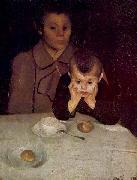 |
Josip Racic
|
|
(1885 - 1908) was a Croatian painter in the early 20th century. Although he died very young (he was only 23), and his work was mostly created when a student, he is one of the best known of the modern Croatian painters. Today, Račić is regarded as one of the most important representatives of Croatian modern painting.
He studied lithography in Zagreb, and 1904 he went to Vienna and Munich, where he studied for a year at the school of the Slovene painter and teacher Anton Ažbe, followed by 3 years at the prestigious Academy of Arts. There, Racic, along with Oskar Herman, Vladimir Becić and Miroslav Kraljević formed the group known as the Croatian School. In 1908, he went to Paris where he painted a series of watercolors and oils depicting Parisian bridges, avenues and parks. He died of a gunshot wound in a Paris hotel room in June 1908, having committed suicide.
Josip Račić is one of the founders of modern Croatian art, the first to bring the concept of self-awareness and artistic integrity to his life and works, "pure painting", as he called it. A particular feature of his paintings is the strong dark realms of human spirituality. A retrospective of his work was held in the Modern Gallery in Zagreb and Dubrovnik in 2008-2009, to mark the 100th anniversary of the artist's death.
|
|
|
|
 |
Jost Amman
|
|
(June 13, 1539, Zerich - March 17, 1591, Nuremberg, Bavaria) was a Swiss artist, celebrated chiefly for his woodcuts, done mainly for book illustrations.
Amman was born in Zurich, the son of a professor of Classics and Logic. He was himself well-educated. Little of his personal history is known beyond the fact that he moved to Nuremberg in 1560, where he continued to reside until his death in March 1591. He worked initially with Virgil Solis, then a leading producer of book illustrations. His productiveness was very remarkable, as may be gathered from the statement of one of his pupils, that the drawings he made during a period of four years would have filled a hay wagon. A large number of his original drawings are in the Berlin print room. About 1,500 prints are attributed to him. He was one of the last major producers of woodcuts for books, as during his career engravings were gradually taking over that role. Although like most artists for woodcut he normally let a specialist formschneider cut the block to his drawing, he sometimes included both a cutter's knife and a quill pen in his signature on prints, suggesting he sometimes cut his own blocks.
A series of engravings by Amman of the kings of France, with short biographies, appeared in Frankfurt in 1576. He also executed many of the woodcut illustrations for the Bible published at Frankfurt by Sigismund Feierabend. Another serial work, the Panoplia Omnium Liberalium Mechanicarum et Seden-tariarum Artium Genera Continens, containing 115 plates, is of great value. Amman's drawing is correct and spirited, and his delineation of the details of costume is minute and accurate. Paintings in oil and on glass are attributed to him, but none have been identified.
|
|
|
|
 |
jozef brandt
|
|
Jozef Brandt (b. Szczebrzeszyn, 1841 - Radom, 1915) was a Polish painter, best known for his paintings of battles.
Brandt studied in Warsaw in the school of J.N. Leszczynski and at the Noblemen Institute. In 1858 he left for Paris to study at the Ecole centrale Paris but was persuaded by Juliusz Kossak to abandon engineering in favor of painting. At one point he studied as a painter under Franz Adam.
|
|
|
|
Jozef Chełmonski
|
|
(November 7, 1849 - April 6, 1914) was a Polish painter.
Chełmoski was born in the village of Boczki near Łowicz in central Congress Poland, Russian Empire. His first drawing teacher was his father (a small leaseholder and administrator of Boczki village). After finishing high school in Warsaw, he studied in Warsaw Drawing Class (1867-1871) and took private lessons from Wojciech Gerson. From 1871 to 1874 Chełmoski lived in Munich. He worked with Polish painters assembled around Jozef Brandt and Maksymilian Gierymski. He also had studied for a few months at the academy of H. Anschutz and A. Strahuber. In 1872 and 1874 Chełmoski visited the Polish territories. Tatra Mountains and Ukraine.
His first paintings were done under the influence of Gerson. The works that followed were landscapes and villages. In 1875 Chełmoski went to Paris, where he had many important exhibitions and became known to the art scene. With many orders, the artistic level of his paintings decreased.
From 1878 to 1887 Chełmoski visited Poland, Vienna and Venice. In 1887 he returned to Poland and in 1889 settled in Kuklewka Zarzeczna village. Contact with his homeland and nature revealed quality in his artworks. From that time are the best liked Chełmoski's paintings such as Partridge on the Snow, The Storks or Before Thunderstorm.
|
|
|
|
Jozef Chełmonski
|
|
(November 7, 1849 - April 6, 1914) was a Polish painter.
Chełmoki was born in the village of Boczki near Łowicz in central Congress Poland, Russian Empire. His first drawing teacher was his father (a small leaseholder and administrator of Boczki village). After finishing high school in Warsaw, Jozef studied in Warsaw Drawing Class (1867-1871) and took private lessons from Wojciech Gerson. From 1871 to 1874 Chełmoki lived in Munich. He worked with Polish painters assembled around Jozef Brandt and Maksymilian Gierymski. There, he also studied for a few months at the academy of H. Anschutz and A. Strahuber. In 1872 and 1874 Chełmoki visited the Polish Territories (Poland, as an independent country, did not exist during this time), Tatra Mountains and Ukraine.
His first paintings were done under the influence of Gerson. The works that followed were landscapes and villages. In 1875 Chełmoki went to Paris, where he had many important exhibitions and became known to the art scene. With many orders, the artistic level of his paintings decreased.
From 1878 to 1887 Chełmoki visited Poland, Vienna and Venice. In 1887 he returned to Poland and in 1889 settled in the village of Kuklewka Zarzeczna. Contact with his homeland and nature are qualities revealed in his artworks. From that time are the best liked, or the most beloved of Chełmoki's paintings are paintings such as Partridge on the Snow, The Storks or Before Thunderstorm.
Chełmoki represented the trend in art called "Polish Patriotic Painting".
He died in Kuklewka near Grodzisk Mazowiecki in 1914.
|
|
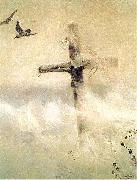 |
Jozef Chelmonski
|
|
(November 7, 1849 -- April 6, 1914) was a Polish painter.
Chełmonski was born in the village of Boczki near Łowicz in central Congress Poland, Russian Empire. His first drawing teacher was his father (a small leaseholder and administrator of Boczki village). After finishing high school in Warsaw, he studied in Warsaw Drawing Class (1867--1871) and took private lessons from Wojciech Gerson. From 1871 to 1874 Chełmonski lived in Munich. He worked with Polish painters assembled around Jozef Brandt and Maksymilian Gierymski. He also had studied for a few months at the academy of H. Anschutz and A. Strahuber. In 1872 and 1874 Chełmonski visited the Polish territories (Poland as a country did not exist then), Tatra Mountains and Ukraine.
His first paintings were done under the influence of Gerson. The works that followed were landscapes and villages. In 1875 Chełmonski went to Paris, where he had many important exhibitions and became known to the art scene. With many orders, the artistic level of his paintings decreased.
From 1878 to 1887 Chełmonski visited Poland, Vienna and Venice. In 1887 he returned to Poland and in 1889 settled in Kuklawka Zarzeczna village. Contact with his homeland and nature revealed quality in his artworks. From that time are the best liked Chełmonski's paintings such as Partridge on the Snow, The Storks or Before Thunderstorm.
Chełmonski represented the trend in art called "Polish Patriotic Painting".
He died in Kuklawka near Grodzisk Mazowiecki in 1914. |
|
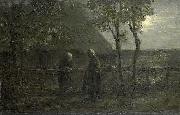 |
Jozef Israels
|
|
(27 January 1824, Groningen - 12 August 1911, Scheveningen) was a Dutch painter, and "the most respected Dutch artist of the second half of the nineteenth century". |
|
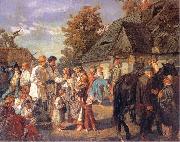 |
jozef marian chelmonski
|
|
Jozef Marian Chełmoski (November 7, 1849 -- April 6, 1914) was a Polish painter.
Chełmoski was born in the village of Boczki near Łowicz in central Congress Poland, Russian Empire. His first drawing teacher was his father (a small leaseholder and administrator of Boczki village). After finishing high school in Warsaw, he studied in Warsaw Drawing Class (1867C1871) and took private lessons from Wojciech Gerson. From 1871 to 1874 Chełmoski lived in Munich. He worked with Polish painters assembled around Jozef Brandt and Maksymilian Gierymski. He also had studied for a few months at the academy of H. Anschutz and A. Strahuber. In 1872 and 1874 Chełmoski visited the Polish territories (Poland as a country did not exist then), Tatra Mountains and Ukraine.
His first paintings were done under the influence of Gerson. The works that followed were landscapes and villages. In 1875 Chełmoski went to Paris, where he had many important exhibitions and became known to the art scene. With many orders, the artistic level of his paintings decreased.
From 1878 to 1887 Chełmoski visited Poland, Vienna and Venice. In 1887 he returned to Poland and in 1889 settled in Kuklewka Zarzeczna village. Contact with his homeland and nature revealed quality in his artworks. From that time are the best liked Chełmoski's paintings such as Partridge on the Snow, The Storks or Before Thunderstorm.
Chełmoski represented the trend in art called "Polish Patriotic Painting".
He died in Kuklewka near Grodzisk Mazowiecki in 1914.
|
|
 |
Jozef Marian Chelmonski
|
|
(November 7, 1849 - April 6, 1914) was a Polish painter.
Chełmoeski was born in the village of Boczki near Łowicz in central Congress Poland, Russian Empire. His first drawing teacher was his father (a small leaseholder and administrator of Boczki village). After finishing high school in Warsaw, Jozef studied in Warsaw Drawing Class (1867-1871) and took private lessons from Wojciech Gerson. From 1871 to 1874 Chełmoeski lived in Munich. He worked with Polish painters assembled around Jozef Brandt and Maksymilian Gierymski. There, he also studied for a few months at the academy of H. Anschutz and A. Strahuber. In 1872 and 1874 Chełmoeski visited the Polish Territories (Poland, as an independent country, did not exist during this time), Tatra Mountains and Ukraine.
His first paintings were done under the influence of Gerson. The works that followed were landscapes and villages. In 1875 Chełmoeski went to Paris, where he had many important exhibitions and became known to the art scene. With many orders, the artistic level of his paintings decreased.
From 1878 to 1887 Chełmoeski visited Poland, Vienna and Venice. In 1887 he returned to Poland and in 1889 settled in the village of Kuklewka Zarzeczna. Contact with his homeland and nature are qualities revealed in his artworks. From that time are the best liked, or the most beloved of Chełmoeski's paintings are paintings such as Partridge on the Snow, The Storks or Before Thunderstorm.
|
|
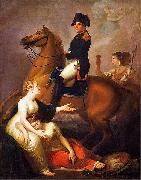 |
Jozef Peszka
|
|
(1767 in Krakew - 1831 in Krakew) was a Polish painter.
He studied painting in Warsaw under Franciszek Smuglewicz. From 1815 he was a professor of painting in Krakew Academy of Arts (Akademia Sztuk Pięknych w Krakowie).
He painted portraits and larger paintings with historical or mythological themes.
|
|
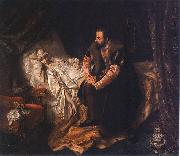 |
Jozef Simmler
|
|
Jozef Simmler (March 14, 1823 - March 1, 1868) was a Polish painter known for his classical style and his Polish subjects.
Perhaps his most famous work is Death of Barbara Radziwillowna. an oil on canvas work completed in 1860. It now hangs in the National Museum, Warsaw. His daughter's brother-in-law was Eduard Strasburger, the famous Polish-German botanist. One of Simmler's grandsons was Henryk Leon Strasburger, a Polish delegate to the League of Nations
|
|
|
|
|
|
|
|
|
|
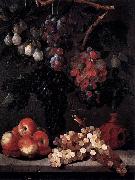 |
Juan Bautista de Espinosa
|
|
(1590-1641, Madrid) was a Spanish still life painter.
More paintings remain of him than biographical data and there is only one known painting remaining.
It is only known that he worked in Toledo and Madrid from 1612 to 1626 and, judging by his style, he was trained in Holland. De Espinosa's style is judged to be the transition from Flemish Baroque to Spanish Baroque.
Several mural paintings in Spanish churches are also attributed to him; one of these is in Alcaudete.
|
|
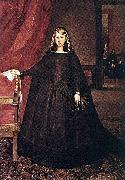 |
Juan Bautista del Mazo
|
|
Juan Bautista Martenez del Mazo (c.1612 - 10 February 1667) was a Spanish Baroque portrait and landscape painter, the most distinguished of the followers of Velezquez, whose style he imitated more closely than did any other artist. A fine painter himself, Mazo was a master of landscape, as proven by his most celebrated work View of Saragossa.
|
|
|
|
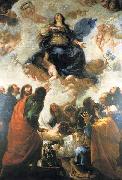 |
Juan Carreno de Miranda
|
|
English: Juan Carreño de Miranda (March 1614-September 1685) was a Spanish painter of the Baroque period.
Español: Juan Carreño de Miranda (Aviles, 1614 - Madrid, 1685) fue un pintor español del siglo XVII, que destace en la Corte española de Felipe IV, y, sobre todo, Carlos II.
|
|
|
|
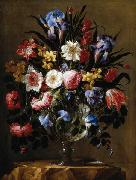 |
Juan de Arellano
|
|
(3 August 1701 - 13 October 1776) was a Spanish painter of the Baroque era who specialized in floral still life paintings.
Born in Santorcaz, near Madrid, where he died. He was a pupil of Juan de Solis. Heavily influenced by Flemish and Italian painters (such as Mario Nuzzi), Juan de Arellano was considered to be exceptional in this thematic. According to one of his colleagues, de Arellano decided to focus exclusively on floral paintings because it offered more pay while requiring less work . Some of de Arellano's most famous pieces include Bouquet of Flowers (c.1660), and Garland of Flowers, Birds and Butterfly, currently on display at the Louvre. He also painted for the sacristy of the church of San Jerenimo el Real of Madrid. See Bodegen for a description of one style of Spanish still life painting. |
|
|
|
|
|
 |
Juan de Flandes
|
|
Flemish-born Spanish Northern Renaissance Painter, ca.1460-1519 |
|
|
|
|
|
|
|
|
|
|
|
|
|
|











